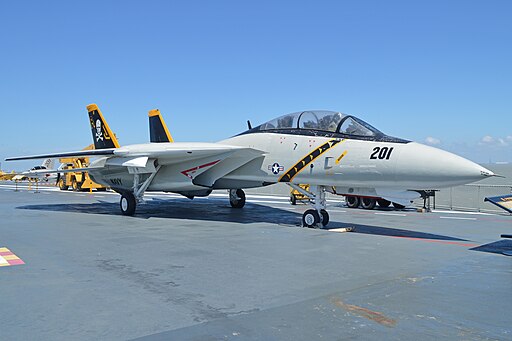The unforgiving vastness of the skies holds a certain allure for those daring enough to navigate them. When one mentions the F-14 Tomcat, what often flashes before one’s eyes is a montage of blistering speeds, dazzling aerial maneuvers, and the undeniably edgy soundtrack of Kenny Loggins playing “Danger Zone” from the 1986 classic movie, ‘Top Gun.’ However, as thrilling as those cinematic depictions may be, the true tales of flying this legendary aircraft are woven with both nail-biting risks and unmatched exhilaration.
The F-14 Tomcat, first gracing the skies in the early 1970s, responded to the need for a superior fleet defense interceptor. Its variable-sweep wings, which could seamlessly adjust to different flight conditions, made it an unparalleled masterpiece of aviation engineering. Not just a pretty face, the Tomcat could dance – and fiercely at that.
Yet, beneath the aesthetics and grandeur, the Tomcat posed challenges that only the most seasoned pilots could embrace. Its raw power and nimble agility demanded an understanding of aerodynamics and an innate ability to ‘feel’ the aircraft. A minor miscalculation, an oversight, and the jet could rapidly transform from a majestic bird of prey to a ferocious beast rebelling against its tamer.
One of the underlying risks of piloting the F-14 stemmed from its engine design. The TF30 engines, especially in the Tomcat’s earlier models, were notorious for compressor stalls. These abrupt power losses during high angle-of-attack maneuvers could lead to asymmetric thrust situations – a nightmare scenario where one engine pushes forward and the other rebels, causing the aircraft to yaw uncontrollably. Many an aviator has recounted tales of narrowly escaping the jaws of disaster due to such anomalies.
Then, there’s the challenge posed by the very feature that made the Tomcat iconic: its variable-sweep wings. While they bestowed the aircraft with unmatched versatility, they also came with their own set of complexities. Transitioning between wing positions required impeccable timing and intuition. Doing so too late or too soon, especially during the throes of combat, could compromise the aircraft’s stability.
But for every risk, there’s a thrill, and the Tomcat always knew how to deliver! Skimming over the vast oceans, chasing the horizon at Mach 2, or swooping down in an aggressive dive only to pull up into a breathtaking climb were moments Tomcat pilots lived for. When those engines roar to life, your heart races. As the world becomes a blur outside, adrenaline courses through your veins. It’s that indescribable rush of controlling something so wildly powerful. An experience that only a select few can say they’ve had, and even fewer can ever shake from their memories.
In a dogfight, you wouldn’t want to be up against the Tomcat; it was a formidable opponent. Its Phoenix missile system could track and eliminate multiple threats, turning the skies into a no-fly zone for adversaries. The blend of technology, design, and human prowess made every sortie an intricate ballet of precision and raw power.
But beyond the thrills and threats, flying the F-14 Tomcat was, for many, a testament to human ingenuity and the age-old desire to conquer the skies. It’s a chapter in aviation history where man and machine forged a bond so intimate it blurred the line between pilot and aircraft. The Tomcat was more than just metal and engineering; it was passion, danger, and poetry in motion.
In the final reckoning, as the sun sets on the age of the Tomcat – now replaced by more modern avian warriors – the legend of this iconic jet persists. Its tales of danger and thrill serve as poignant reminders of a time when bravery, skill, and innovation soared together in the endless expanse of the blue yonder.
For more insights into the F-14A Tomcat and other important military aircraft, visit Aces In Action. Here, you’ll find an amazing piece of artwork by Craig Tinder titled “Fear the Bones” which illustrates the honors of the crews of the Fighting VF-84 “Jolly Rogers” Fighter Squadron who flew the F-14A Tomcat in the 1970s-1980s. The limited edition canvas print even includes a piece of an actual relic from a Pratt & Whitney TF-30 Turbofan Jet Engine as was used on the F-14A Model of the Tomcat., making it a unique piece of history!
Fear the Bones – F-14A Tomcat Aviation Art by Artist Craig Tinder
Conducting fleet air defense exercises, Commander Rob Ferguson and Ensign Jay Rogers of VF-84 “Jolly Rogers”, gain altitude high above the U.S.S. Nimitz. When paired with the AIM-54 Phoenix missile, the Grumman F-14A Tomcat had a lethal range of over 100 nautical miles and could track up to 24 different targets simultaneously. The F-14 Tomcat proudly served the U.S. Navy from 22 Sept. 1974 to 22 Sept. 2006 – 32 years to the day.






Share:
Allied Wings: The F-4 Phantom’s Service in Foreign Air Forces
Heinkel He 111 in the Spanish Civil War: A Combat Debut That Sculpted Aeronautical Warfare